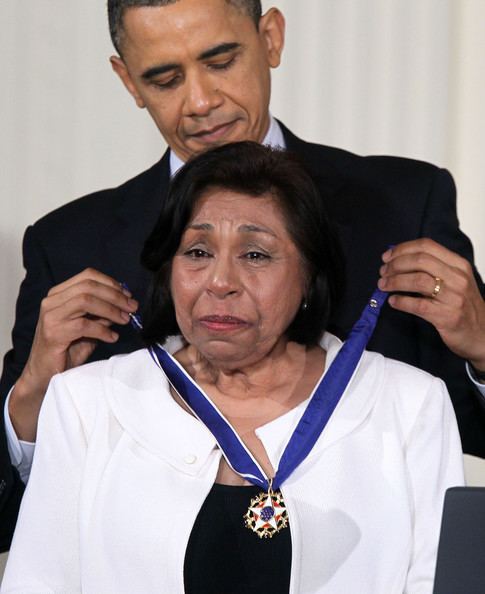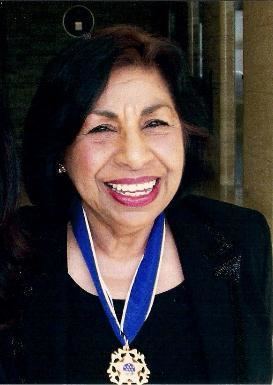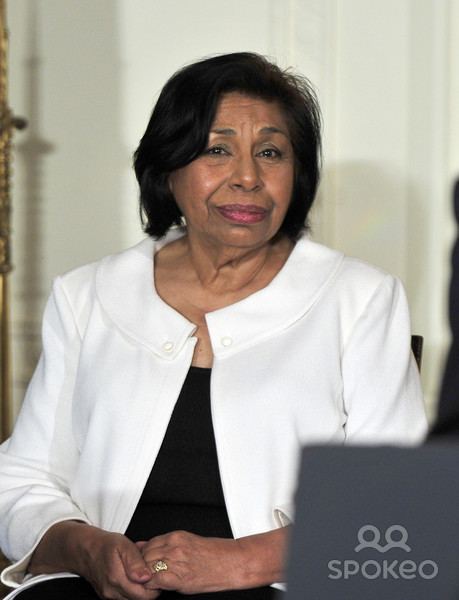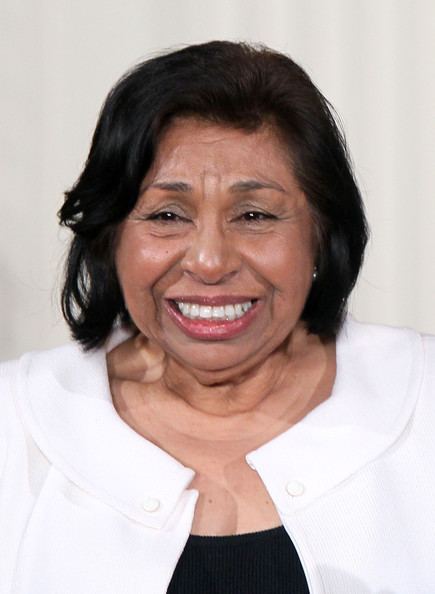Name Sylvia Mendez | ||
 | ||
Occupation American civil rights activist of Mexican-Puerto Rican heritage. Siblings Gonzalo Mendez Jr., Phillip Mendez, Jerome Mendez, Sandra Mendez Duran, Victor Mendez People also search for Felicitas Mendez, Gonzalo Mendez Jr. Similar Felicitas Mendez , Duncan Tonatiuh , Dolores Huerta | ||
Sylvia mendez
Sylvia Mendez (born 1936) is an American civil rights activist of Mexican-Puerto Rican heritage.
Contents
- Sylvia mendez
- Voices of history sylvia mendez
- Early years
- Mendez v Westminster
- Aftermath
- Legacy
- References

At age eight, she played an instrumental role in the Mendez v. Westminster case, the landmark desegregation case of 1946. The case successfully ended de jure segregation in California and paved the way for integration and the American civil rights movement.

Mendez grew up during a time when most southern and southwestern schools were segregated. In the case of California, Hispanics were not allowed to attend schools that were designated for "Whites" only and were sent to the so-called "Mexican schools." Mendez was denied enrollment to a "Whites" only school, an event which prompted her parents to take action and together organized various sectors of the Hispanic community who filed a lawsuit in the local federal court. The success of their action, of which Sylvia was the principal catalyst, would eventually bring to an end the era of segregated education. She was awarded the Presidential Medal of Freedom, the United States' highest civilian honor, on February 15, 2011.

Voices of history sylvia mendez
Early years

Mendez was born in 1936 in Santa Ana, California. Her parents were Gonzalo Mendez, an immigrant from Mexico who had a successful agricultural business, and Felicitas Mendez, a native of Juncos, Puerto Rico. The family had just moved from Santa Ana to Westminster to tend a farm that they were renting from the Munemitsus, a Japanese-American family that had been sent to an internment camp during World War II. This took place during a period in history when racial discrimination against Hispanics, and minorities in general, was widespread throughout the United States.
In the 1940s, there were only two schools in Westminster: Hoover Elementary and 17th Street Elementary. Orange County schools were segregated and the Westminster school district was no exception. The district mandated separate campuses for Hispanics and Whites. Sylvia and her two brothers, Gonzalo Jr. and Jerome Mendez, attended Hoover Elementary, a two-room wooden shack in the middle of the city's Mexican neighborhood, along with the other Hispanics. 17th Street Elementary, which was a "Whites-only" segregated school, was located about a mile away. Unlike Hoover, the 17th Street Elementary school was amongst a row of palm and pine trees and had a lawn lining the school's brick and concrete facade.
Realizing that the 17th Street Elementary school provided better books and educational benefits, Gonzalo decided that he would like to have his children and nephews enrolled in there. Thus, in 1943, when Sylvia Mendez was only eight years old, she accompanied her aunt Sally Vidaurri, her brothers and cousins to enroll at the 17th Street Elementary School. Her aunt was told by school officials, that her children, who had light skin would be permitted to enroll, but that neither Sylvia Mendez nor her brothers would be allowed because they were dark-skinned and had a Hispanic surname. Mrs. Vidaurri stormed out of the school with her children, niece and nephews and recounted her experience to her brother Gonzalo.
Mendez v. Westminster
Mendez's father Gonzalo and his wife Felicitas took on the task of leading a community battle that changed California, and set an important legal precedent for ending segregation in the United States. Felicitas attended the family's agricultural business, giving Gonzalo time to meet with community leaders to discuss the injustices of the segregated school system. Initially, Gonzalo received little support from the local Latino organizations, but finally, on March 2, 1945, he and four other Mexican-American fathers from the Gomez, Palomino, Estrada, and Ramirez families filed a lawsuit in federal court in Los Angeles against four Orange County school districts — Westminster, Santa Ana, Garden Grove, and El Modena (now eastern Orange) — on behalf of about 5,000 Hispanic-American schoolchildren.
During the trial, the Westminster school board insisted that there was a "language issue", however their claim fell apart when one of the children was asked to testify. The testimony proved that most of the children spoke English and showed that Hispanic-American students had the same capacity for learning as their white counterparts.
On February 18, 1946, Judge Paul J. McCormick ruled in favor of Mendez and his co-plaintiffs. However, the school district appealed. Several organizations joined the appellate case as amicus curiae, including the ACLU, American Jewish Congress, Japanese American Citizens League, and the NAACP which was represented by Thurgood Marshall. More than a year later, on April 14, 1947, the Ninth Circuit Court of Appeals affirmed the district court's ruling in Mendez v. Westminster in favor of the Mexican families. After the ruling was upheld on appeal, then-Governor Earl Warren moved to desegregate all public schools and other public spaces in California.
Aftermath
Mendez finally was allowed to attend the 17th Street Elementary school, thus becoming one of the first Hispanics to attend an all-white school in California. However, the situation was not easy for her. Her white peers called her names and treated her poorly. She knew that she had to succeed after her father fought for her to attend the school. Gonzalo Mendez died in 1964 at the age of 51, unaware of the impact that the case for which he fought would have on the nation.
Mendez v. Westminster set an important precedent for ending segregation in the United States. Thurgood Marshall, who was later appointed a Supreme Court justice in 1967, became the lead NAACP attorney in the 1954 Brown case. His amicus brief filed for Mendez on behalf of the NAACP contained the arguments he would later use in the Brown case. The Mendez case also deeply influenced the thinking of the California governor at the time, Earl Warren. By 1954, when the Brown case appeared before the high court, Warren had become the chief justice.
Legacy
In April 1998, Felicitas Mendez died of heart failure at her daughter's home in Fullerton, California. Mendez became a nurse and retired after working for thirty years in her field. She adopted two girls and lives in Fullerton, California. She travels and gives lectures to educate others on the historic contributions made by her parents and the co-plaintiffs to the desegregation effort in the United States. The success of the Mendez v. Westminster case made California the first state in the nation to end segregation in school, paving the way for better-known Brown vs. Board of Education seven years later, which would bring an end to school segregation in the entire country.
Sandra Robbie wrote and produced the documentary Mendez v. Westminster: For all the Children / Para Todos los Ninos, which debuted on KOCE-TV in Orange County on September 24, 2002 as part of their Hispanic Heritage Month celebration. The documentary, which also aired on PBS, won an Emmy award and a Golden Mike Award.
A ribbon-cutting ceremony was held in the Los Angeles County Law Library for the opening of a new exhibit in the law library display case titled "Mendez to Brown: A Celebration." The exhibit features photos from both the Mendez and Brown cases, in addition to original documents. In 1998, the district of Santa Ana, California honored the Mendez family by naming a new school the "Gonzalo and Felicitas Mendez Fundamental Intermediate School", after Sylvia Mendez's parents. In 2004, Mendez was invited to the White House for the celebration of National Hispanic Heritage Month. She met with President George W. Bush, who shared her story with key Democrats, including U.S. Senator Hillary Clinton of New York.
On April 14, 2007, the U.S. Postal Service unveiled a stamp commemorating the Mendez v. Westminster case. The unveiling took take place during an event at Chapman University School of Education, Orange County, California commemorating the 60th anniversary of the landmark case.
On September 9, 2009 a second school opened in the Los Angeles community of Boyle Heights bearing the name "Felicitas and Gonzalo Mendez Learning Center." The dual school campus commemorated the efforts of the Mendez and other families from the Westminster case.
An exhibit honoring Mendez v. Westminster was scheduled to open in September 2011, at the Old Courthouse Museum in Santa Ana. This exhibit known as "A Class Act" is sponsored by the Museum of Teaching and Learning. Sylvia Mendez is a member of the exhibit planning committee along with her brother, Gonzalo.
On February 15, 2011, Sylvia Mendez was awarded the Presidential Medal of Freedom. In 2012, Brooklyn College awarded Sylvia Mendez an honorary degree.
